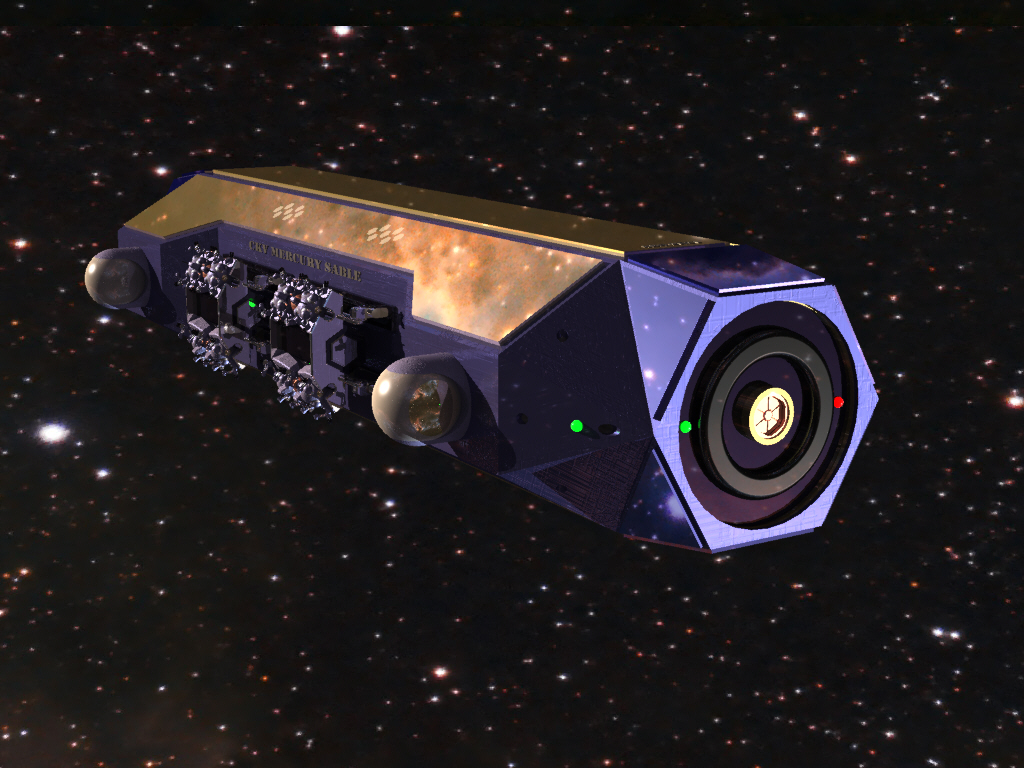CKV Mercury Sable
The venerable CKV Mercury Sable is a Tetrain-class cruiser. The vessel served the Cobalt Knights for a long time as a 'Q-ship' hunting Aniki Labs commerce raiders in the Evermorn System. The Sable was temporarily mothballed - pending salvage - after a run-in with the raiders that cost two of its crew's lives and left its pilot, Knight-Airman Enzo Salt, severely injured. After Salt's recovery, Sara used his backpay to save the vessel from the shipbreakers' yard, freeing it for refit and use aboard the ESCI Revelation where the pair now serve under the auspices of the Evermorn Strategic Colony Initiative.
Power Generation
While primary power is provided by thermal gradients from the vessel's fusion drive (see Propulsion), auxilliary power is provided by a set of regenerating hydroxide fuel cells. In emergencies, a set of small solar panels dotted around the vessel can provide a tiny amount of power to allow a distress signal to be sent and the life support system to continue operating in a minimal state. Large banks of capacitors provide the spark required to re-initiate fusion should shutdown be required.
The Mercury Sable's outer hull includes a cooling jacket and integrated radiator panels that take up the majority of the vessel's exterior surface. These panels are comprised of a carbon-composite material that is transparent to infrared radiation, allowing the coolant to disperse waste heat while still remaining protected beneath a layer of transparent armor. During combat, water from the GPM jackets (see Hangars & Docked Vessels) can be expelled through the drive systems (see Propulsion) to provide open-cycle cooling in addition to improved thrust. When underway and not in combat, the Sable's systems endeavor to cool the ship as much as possible to provide an additional buffer of heat capacity for the drive and laser systems; warm jackets and thick blankets are provided to the crew for this reason.
Propulsion
The Mercury Sable is propelled by a deuterium-tritium toroidal fusion drive which also provides electrical power for the ship's systems. At least one - but most often two - of the vessel's General Purpose Module(GPM) slots (see Hangars & Docked Vessels) are occupied by fuel tanks containing all the D-T fuel (usually in the form of heavy water) and lithium blanket material the drive will need to remain functioning for potentially years without refit. This drive system is trimodal, allowing for a power generation mode (no thrust and minimal fuel consumption), cruising mode (high ISP/low thrust with purely magnetically-accelerated fusion products for reaction mass), and afterburner mode (low ISP/high thrust by injecting water vapor into the exhaust stream). This arrangement gives the Mercury Sable, like all vessels of the Tetrain class, exceptional field endurance without compromising its utility as a combat vessel.
A set of reaction wheels provides minimal corrections to the vessel's orientation, while microwave electrothermal (MET) steamers provide coarse attitude control. These MET steamers utilize water from the ice jackets of the fuel GPMs for reaction mass and are powered by the fusion drive.
Weapons & Armament
The four turreted multispectral scope arranged around the medial surfaces of the Mercury Sable rely on LIDAR for active sensing, and the ultraviolet beams used for this purpose can be intensified and focussed down to provide point defense and near- to mid-range offensive fire. Enemy optical sensors are typically targeted first to blind the opponent and potentially also rob them of a similar method of attack. These lasers are inherent to the structure of the vessel and remain the same regardless of the Sable's current consist (see Hangars & Docked Vessels).
The second GPM in the Mercury Sable's consist, behind the habitation module and ahead of the first fuel module, is usually an ordinance module packed to the brim with directed fission torpedoes (with bomb-pumped laser submunitions) of the "Sungazer" variety. Launch cells extend from the exterior dorsal hull of the vessel into a matching set of cells on the exterior of the ordinance GPM; projectiles leave the cells, perform a skew turn towards the target after a brief delay, then rocket towards the target under guidance from the Sable's targeting computer.
Armor and defense
The inner and outer hull of the Mercury Sable are comprised of graphene composite materials designed to resist impacts and abrasion without excessive weight. The outer hull of the vessel stands away from the inner hull, and a series of powerful electromagnet coils fills the gap between them. The magnetic field produced by these coils helps to reduce stellar particle radiation over the long-term, but it also helps to deflect particle beam weapons and the hazardous byproducts of nuclear explosions in nearby space. Varying the strength and configuration of the electromagnetic field has the additional benefit of providing magnetohydrodynamic control over the ship's exhaust, allowing the Sable to make use of thrust vectoring. The inner hull has an additional layer of field-damping mesh to reduce interference with the electronics inside.
The composite pykrete jackets of the GPMs (see Hangars & Docked Vessels) provide an additional layer of protection against impact and particle radiation for the crew. Gold foil stitched into the inner layer of these jackets provides a modicum of protection against electromagnetic radiation, such as gamma rays and x-rays from nuclear weaponry.
One secret aspect of the Mercury Sable's defensive complement is its non-descript nature. The Tetrain class of cruisers are frequently resold on the civilian market for use as asteroid mining platforms, making for excellent surveyor and drone control vessels. The multi-layered hull design makes attempts to guess the composition of the vessel's consist extremely difficult, with drive signatures and velocities showing little more than the mass distribution and relative power of the vessel. For this reason, the Mercury Sable was able to masquerade as civilian mining vessel for many years, lying in wait for commerce raiders looking to pirate it or its spoils. Once approached by a would-be pirate, the Sable would quickly dispatch the attackers with hidden weaponry before closing to board. The ALV Pyre Dawn was the last Aniki vessel to fall prey to this tactic on the part of the Mercury Sable's crew.
Communication Tools & Systems
The Mercury Sable communicates primarily through tight-beam laser pulses, including when passing orders between the pilot and drones (see Hangars & Docked Vessels). Secondary radio-wave antennae integrated into the outer hull permit broad-area communiques, though these are of limited range and more useful in emergencies or when masquerading as a civilian vessel (see Armor & Defense).
Sensors
In addition to optical sensing through its multispectral scopes (see Weapons & Armament), the Mercury Sable can detect objects in nearby space through a combination of fluctuations in its protective magnetic field (see Armor & Defense) and a series of Forward gravitational detectors scattered about the hull. The ship's sensor data - as well as any additional data provided by drones (see Hangars & Docked Vessels) - is coallated by the ship's computer before being pumped into the pilot's sensoriate via brain-computer multitasking interface implant. All sensor systems may also be accessed through secondary means in the event of strong enemy electronic warfare, though this is not nearly as efficient as using cybernetic augmentations.
Additional & auxiliary systems
The Mercury Sable comes equipped with a force docking array, allowing it to deliver a boarding party of espatiers into an enemy vessel whether that vessel is compliant or not. Best practices dictate that an opponent's drive systems be incapacitated before attempting such a maneuver, as jostling around during such a forced docking maneuver can prove fatal to man and machine alike.
Hangars & docked vessels
In keeping with the Evermornan cultural propensity for multiple redundancy and modularity, the Sable, as with all members of its class, is almost completely modular. The CKV Mercury Sable designation is acknowledge for the hull, frame, and computer system; almost all other parts can be swapped aroud without changing the legal identity of the craft, though components are typically installed on such vessels in a lease-to-buy arrangement in the civilian sector.
The "consist" of the Mercury Sable refers to its arrangement of four general purpose modules mounted in its interior saddle trust and four utility modules mounted on the pairs of brackets on the port and starboard sides of the hull. The Sable's interior consist usually includes a habitation module, ordinance module, and two fuel modules. The vessel's exterior consist usually includes a full complement of RD-1 "Razorbill" Space Combat Drones, though railgun batteries and scout-surveyor drones have also been fielded in the past. In its usual configuration, the Mercury Sable's pilot commands a flight of sixteen drones simultaneously and has sufficient closed-ecology live support system (CELSS) capacity to loiter for more than a year between refits and restockings.
Class
Nickname
Sable
Designation
CKV Mercury Sable
Manufacturer
Owner
Owning Organization
Related Technologies
Beam
100' (including laser arrays)
Length
250'
Height
50'
Complement / Crew
4
Cargo & Passenger Capacity
6, plus 10 per additional habitation GPM




I was not expecting to see the term 'pyrkrete' in this sci-fi vehicle. Space vehicles can get really pseudo-science and jargon filled. It was really nice to see the small touches of “as added protection out in the cold wastes of space, he insulated our ship with the cold wastes of space.” However useful it actually would be, it seems economical, replenish-able, and almost inherently logical in a space-age way. Not sure if this idea is originally yours, but it is original to me and I super enjoy it.
Thanks! Much as I'd like to lay claim to the idea of inflatable spacecraft with ice in the walls, GPMs are an evolution on real-word module concepts like the NASA TransHab, Bigelow B330, and McConnell & Tolley "Spacecoach." Atomic Rockets has great write-ups for these and was a major inspiration for this setting.